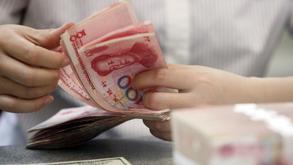With US Fed tightening seen slowing, currency gains may lift equities
 A worker counts Chinese currency renminbi at a bank in Linyi, East China's Shandong province. (XINHUA)
A worker counts Chinese currency renminbi at a bank in Linyi, East China's Shandong province. (XINHUA)
Sentiment in the foreign exchange market improved further on Monday as outlook for China's economic growth brightened against the backdrop of the country's strong resilience and expectations that the US Federal Reserve's monetary tightening is likely to slow down, experts said.
The USD/CNY central parity rate offered by the China Foreign Exchange Trade System — the most important reference indicator for the spot interbank foreign exchange market — came in at 7.0899 on Monday, with the renminbi appreciating by 1,008 basis points against the greenback. It is the RMB's biggest daily surge since July 22,2005.
The RMB's spot rate against the US dollar also jumped more than 300 basis points as soon as trading started on Monday morning to touch 7.0652.
Bullish signs have been emerging this month, market insiders said. The USD/CNY central parity rate gained 648 basis points between Nov 4 and 11, with the biggest daily jump of 515 points reported on Friday during the eight-day period. Therefore, the RMB's onshore and offshore exchange rates against the US dollar both regained the 7.1 psychological threshold on Friday.
Zhou Maohua, an analyst at China Everbright Bank, said the US dollar index has dropped significantly over the past few trading days mainly because US inflation started to fall in October and the Fed is expected to slow down its interest rate hike pace. This has been partly responsible for the RMB's recent rebound.
On Friday, the US dollar index closed nearly 7 percent off this year's peak of 114 points, and at the lowest level since August.
The improving outlook for China's economic growth and the brightening of market mood have helped push up the prices of most RMB-denominated assets, said Zhou.
He Chao, head of macroeconomic research at Xiangcai Securities, said that RMB's exchange rate will remain stable at a rational level in the mid to long run, thanks to the adequate room for adjustments in China's fiscal and momentary policies and the country's strong economic resilience.
The benchmark Shanghai Composite Index and the Shenzhen Component Index slid 0.13 percent and 0.24 percent, respectively, on Monday.
But prices of public property developers gained 1.36 percent on average. This was mainly because of the announcement by top financial regulators, including the China Banking and Insurance Regulatory Commission, on Monday, which encouraged quality property developers to apply for supervised presale funds by providing letters of guarantee.
International investors' confidence in the A-share market remained strong, as northbound capital — funds used by overseas investors to buy A shares via the stock connect program linking the Shanghai, Shenzhen and Hong Kong exchanges — reported a net inflow of 16.6 billion yuan ($2.4 billion).
According to the notice released by the State Council's Joint Prevention and Control Mechanism on Friday, 20 measures were rolled out to optimize COVID-19 control measures. These policies will help further improve market expectations for economic fundamentals, said Qin Peijing, chief strategist of CITIC Securities.
The 20 measures signify a more scientific and precise approach to fend off the epidemic so as to ensure the impact on the economy will be minimal. The stabilizing policies introduced earlier this year will be able to better support economic growth, he said.
On top of that, the US Fed's interest rate spikes are expected to slow down and the US stock market's temporary rebound is coming to an inflection point. The trend of the RMB's depreciation is likely to end soon, creating more room for the A-share market recovery, he said.


